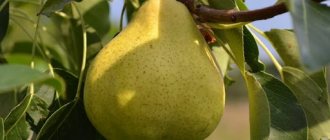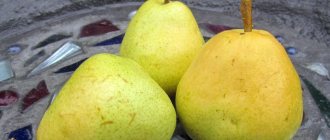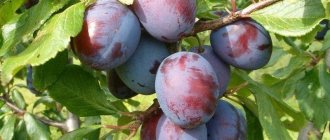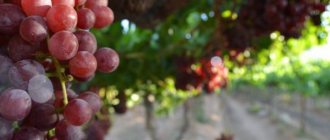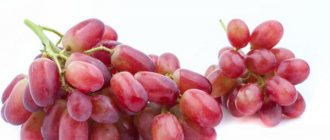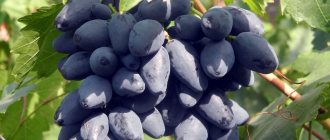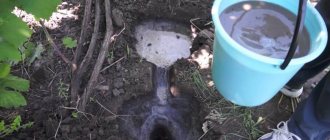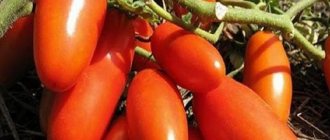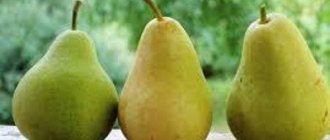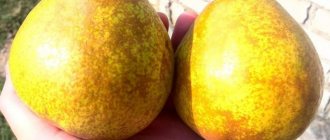Kokinskaya pear.
Description of the variety
The pear was launched at the stronghold of the same name. To create Kokinskaya, pollen from Cure and Popular was used.
Characteristics of wood
The Kokinsky pear is medium-sized, it reaches a height of 4 meters, and the crown is medium-thick in diameter and reaches 3 meters. The tree is winter-hardy and tolerates low temperatures well; only young buds can suffer from recurrent frosts.
Description of fruits
Kokinskaya.
Fruits of the Kokinskaya variety are medium in size and slightly above average. The maximum weight reaches 250 grams. The shade is light green, turns yellow as it ripens and develops a pink-red blush.
The pulp is white, juicy with a dessert taste. Most of the taste qualities are sweet, but there is a slight, barely noticeable sourness.
Characteristics of the variety
This fruit gained popularity due to the possibility of growing on an industrial scale. Fruits can be stored in rooms with low temperatures for 2-3 months. The main thing is that the picked fruits are undamaged.
Ripening begins 3 years after planting. There is a high yield - about 100 kg per 1 m2.
Weather conditions do not become a big problem for trees. Not afraid of severe frosts and icing. At low temperatures, the buds may freeze, but the pear will still survive. The plant is characterized by immunity to diseases, especially scab.
The plant is unpretentious to the quality of the soil. In addition to drainage soil, sandy loam, slightly acidic, turf, medium podzolic, and light loamy soils are suitable.
Trees of this type are considered self-fertile. That is, the pollination process does not require additional pollinating plants.
Description of the tree
According to the description, the Kokinskaya pear reaches a height of 4 m. The diameter of the crown is up to 2.5 m. The trunk is straight, the crown is not too thick. The leaves are round in shape and rich green in color.
The plant needs regular pruning of branches. The purpose of the procedure is to form a pyramid shape.
Description of fruits
The description shows that the fruit can weigh up to 250 grams. The pulp tastes sweet and sour, light and juicy. However, after several large harvests, the size of the fruit begins to decrease.
Appearance of fruits:
- the stalk is strong and thick, slightly curved in shape;
- the color of the fruit can be green, after ripening - yellow, sometimes with a red side;
- clearly visible points under the skin;
- wide pear-shaped fruit.
Kokinskaya pears are sweet, without sourness. There is no astringency in the taste.
Can be consumed fresh or in the form of jam and compotes. They also make jams, confitures, and pastilles. Sometimes they are used to make sweet wines or juices.
The fruits are hypoallergenic, therefore they are allowed for consumption by children from 6 months.
Reviews
The Kokinskaya pear has been growing on my site for only 5 years. This year we tried the fruit, which was quite tasty. There wasn't enough for jam, just to try. The tree itself hasn't caused any trouble yet. But I insulated it as expected.
Philip
Krasnoyarsk
The fruits from Kokinskaya suit me quite well. They have a pleasant taste and look pleasing. Enough to eat for jam. They don't last long, but I have winter pears, so that's not a problem.
Elizabeth
Omsk
I don’t see anything special in this pear, but there’s nothing bad to say either. There is enough fruit to eat and make jam. My wife cooks it in pieces, it turns out like marmalade.
Anton
Cherepovets
Choosing a landing site
Planting time depends on climate and region. In the northern regions, the tree is planted in mid-spring, when stable warm weather has established itself and there is no frost at night. In the southern regions, this procedure is recommended to be performed in early autumn.
As for the soil, loose, moderately heavy soil is perfect for growing pears. The tree is best planted in a spacious, ventilated area in direct sunlight.
The best place for planting will be the south or west side of the site.
Landing
Proper planting of the Kokinskaya pear variety lies in the correct choice of timing, seedling and location. Otherwise, the planting procedure is standard, as for all other pear trees. More details about all procedures can be found in the articles below.
How to plant a pear tree correctly
At what distance to plant pears?
How to choose pear seedlings
How to replant a pear
Diseases
The Kokinskaya variety is resistant to diseases and pests. But improper care can cause scab and moniliosis.
To protect the tree from scab, it is important to moderately water and feed the seedling, and carefully loosen the soil around it. Other preventive measures include removing weeds and removing fallen leaves in the fall.
The second disease that affects this variety is moniliosis or monilial burn. It is caused by the fungus Moniliafructigena. Fruits suffer from its effects. Therefore, it is important to remove affected pears in a timely manner. It is necessary to carry out treatment with a 3% solution of boric liquid before flowering begins and after it ends.
Care
Proper care of the Kokinskaya pear consists of a number of procedures. This includes: correct and timely watering, fertilizing, pruning the crown for sanitary and shaping purposes. You can read about all these procedures using the links in the articles below.
How to care for a pear Pruning a pear Pruning a columnar pear Treating a pear from diseases and pests Feeding a pear How to water a pear
Features of care
It is important to plant this type of pear in the right place. A rowan tree growing nearby is a bad neighbor, since these trees have the same pests and diseases. The best option would be to plant a pear next to an apple tree.
Watering rules
- Pear loves moisture very much; it is especially necessary to frequently moisten the soil during the flowering period.
- On hot summer days, also do not forget about moistening the soil. Experienced gardeners suggest a method of moistening in the form of spraying. In this case, a crust does not form on the soil surface.
- Water enters the root system in the right amount. Together with moisture, the roots are saturated with oxygen, which is very important for the development and subsequent abundant fruiting of the tree.
Weeding, loosening and mulching
These procedures must be carried out at least 3-4 times during the summer season. Do not allow crust in the circle around the trunk. It is necessary to carefully but carefully loosen the soil with a shovel or hoe.
Closer to the edge of the circle, bury the tool 10 - 15 cm, near the trunk no more than 5 cm. This way the root system will not be damaged, and oxygen and moisture will flow into the roots in the right quantities.
If it is not possible to regularly water the seedling, especially in hot weather, then the tree trunk circle should be mulched. Weeds will not grow and take away nutrients from the pear, and moisture will remain in the ground for a longer period.
As mulch, you can use pine needles, mown grass, hay and straw, crushed wood bark, and sawdust.
Fertilizer
- If you fertilized the soil during planting, then the next fertilizing should be applied only the next year. Regardless of when the seedling was planted - in spring or autumn. Mineral fertilizers and organic matter are usually applied.
- The soil is fed at least 2 times annually. It is especially necessary to regularly add useful and nutritious substances when the soil is poor and the tree is weak and developing poorly.
Trimming
In the spring, before the sap begins to flow and leaves bloom, formative or sanitary pruning is carried out. The first type involves pruning branches in order to give the crown the correct shape. And sanitary work is carried out to rid the tree of damaged, dry, diseased branches and branches growing in the center of the crown. There are several basic rules for pruning.
- It is not recommended to eliminate too many shoots at one time, even if the tree is neglected. Don't forget that this is stressful for him.
- It is not advisable to leave stumps and recesses - they take a long time and do not dry out well. The pear's immunity weakens. All sections must be treated with garden varnish to avoid introducing infection into the tissue.
- Do not allow branches that are large in diameter to break off. If this happens, carefully process the cut so that the juice does not attract harmful insects.
- In summer and winter, pruning is not done, since the cuts do not have time to tighten. As a result, the tree loses a lot of strength and may begin to hurt.
Diseases and pests
The immunity of the Kokinskaya pear can be described as above average. But fruits are not as protected from scab as leaves. It is necessary to carry out preventive and protective measures if necessary. You can read about all the procedures that will help protect the pear from diseases and harmful insects in the articles below.
Dangerous Pear Pests
Pears often suffer from pests, they affect the leaves, bark and fruits.
In this article, we have selected 11 of the most harmful insects that harm pear trees, and also ways to destroy them.
Diseases of pear trees
To get what they cherish, gardeners have to work hard, and the reason for this is pear diseases.
Read about 19 common pear diseases and how to combat them.
Prevention and protection against pests and diseases
Despite the fact that the variety is resistant to fungal diseases and is not particularly affected by pests, gardeners recommend taking preventive measures to prevent their occurrence. The fruits of this variety are quite resistant to scab, but the leaves can be affected by this disease. To eliminate the risk of scab, chemicals are used to treat wood. For this purpose, chemicals such as Bordeaux mixture 3%, Chorus or Topaz are used.
Spraying is carried out at the beginning of spring, as well as immediately after abundant flowering of trees. Another scourge that pear trees can be susceptible to is moniliosis (gray fruit rot). This fungal disease is provoked by heavy rainfall in the summer. The cause may also be rotten pears that were not picked and survived the winter on the trees.
Did you know? Pears contain a natural antibiotic. These fruits suppress inflammatory processes and are especially useful for ailments of the genitourinary system. Traditional medicine uses this culture to treat prostatitis.
To protect the garden from this disease, it is recommended to carry out the following preventive work:
- completely collect all the fruits, without leaving them on the branches and under the tree;
- carry out regular inspection of the tree and remove branches and shoots affected by rot;
- carry out treatments with chemicals (copper chloride, “Topsin-M”).
The chemical preparation “Profilaktin” helps well against pests that have been able to survive the winter. It prevents the appearance of insects such as leaf rollers, aphids, scale insects, and mites.
Kokinskaya pear - self-fertile variety
Kokinsky pear is a late-ripening variety. Characterized by excellent dessert taste. The ancestors of the culture were the Popular and Curé varieties. This variety has not yet acquired a squad of loyal fans. However, the Kokinskaya variety has a lot of advantages that gardeners do not know about. That's why we decided to tell more about the culture.
Next, you will find out what the tree looks like, whether the Koka pear is self-fertile, when the fruits ripen, how long the fruits are stored, in which regions the yield reaches its maximum, and much more.
Agrotechnical characteristics
Representatives of the cultivar are medium-sized plants; an adult tree can reach about 4 m in height. The crown shape is broadly pyramidal, medium dense. The main branches grow in relation to the trunk at an angle of approximately 45°. The variety is characterized by a medium degree of crown density, so over time the trees require formative pruning. If this is not done, there is a risk of getting a harvest of small pears.
The leaves of the variety are juicy dark green in color, large, oval in shape with a sharp tip. The edges of the leaves are finely serrated.
The fruits of the Kokinskaya pear are medium or large in size, classic, broadly pear-shaped. The weight of ripe fruit ranges from 100 to 200 g. The color of the fruit peel as it ripens changes from light green to an appetizing yellow color with a crimson blush on the sunny side. The stalks are strong, long, slightly curved.
The characteristics of the pulp are also excellent - juicy, tender, medium density, simply melts in the mouth. The color of the pulp varies from white to cream. A ripe pear has a wonderful dessert sweet taste with a slight sourness, without any astringency. Fruits of this variety are intended for fresh use, for preservation, and withstand transportation well. The variety is also characterized by good keeping quality of fruit; when kept in the refrigerator, pears can be stored until November.
The best pollinators - neighbors for the variety will be Bergamot and Lyubimitsa Yakovleva pears. To obtain stable yields, a seedling of one of these cultivars should be planted on the site.
The fruiting stage of seedlings begins 4–5 years after planting on the site. Kokinskaya pear is considered a high-yielding variety; the total weight of harvested fruit can reach almost 100 kg.
What does an adult Kokinskaya tree look like?
The culture is a representative of medium-sized plants. The crown of the tree is quite wide. It has a pyramidal shape. The crown density is average. The trunk of the pear is slender. The skeletal branches are located at an angle of forty-five degrees. Fruits begin to form four or five years after the tree has been planted in open ground. The fruits grow medium or large. The weight of one fruit varies from 100 to 200 grams.
The shape of the fruits is wide, pear-shaped. Their stalk is elongated, thickened and slightly curved. The peel of the fruit is green-yellow with a pinkish tint on the illuminated side. The inside of the fruit is white or creamy. The consistency is oily and juicy. The taste of the Kokinskaya fruit is sweet, without sourness or spice.
The height of the tree is on average 4 meters. The width of the crown of the plant is usually no more than 3 meters. Periodically, the crown needs to be thinned and excess branches trimmed. By the way, this pear variety produces a large harvest under good conditions. Gardeners claim that an adult plant can produce up to 100 kilograms of fruit.
The culture is frost-resistant. If the winter is very cold, the kidneys may freeze. This factor will completely affect the amount of pear harvest. The plant itself, however, will remain intact and will not suffer from low temperatures, but the yield will be noticeably reduced. Another characteristic of the cokin pear is its immunity to various bacterial and viral diseases, in particular scab. However, fruits mostly have this immunity. But the leaves may well suffer from scab.
Basic Description
The Kokinskaya pear has another name - “Bryansk souvenir”. Many gardeners know this variety by its last name. Reviews about the pear are positive, as it has many advantages.
Origin
- The pear is classified as an early autumn variety. Kokinskaya was bred from such famous cultivars as the French variety “Cure” and the no less famous pear “Popular”.
- The authors of this variety were a group of breeders led by A. A. Vysotsky. She appeared near Bryansk, in the Kokinsky stronghold of VSTISP.
- This variety is positioned as light-loving and frost-resistant.
Characteristic features of the variety
This variety of pear is loved by farmers who sell fruits, including pears. If the fruits are picked whole and undamaged, they can be stored for about 2 - 3 months.
- The first decent harvest can be obtained 3 - 5 years after planting the seedling. The yield is very good. From 1 m2 you can get approximately 100 kg.
- Pear can withstand almost all temperatures. Winters successfully. If the frosts are very severe, the buds may freeze, but the tree itself quickly recovers.
- Also, a characteristic feature of the variety can be called very good immunity against a disease characteristic of pears, such as scab.
- The composition of the soil can be almost any. Kokinskaya pear grows well on all main types of soil: sandy loam, turf, medium podzolic, light loamy with a low level of acidity.
- Another undoubted advantage is that the variety is self-fertile. This is convenient, since there is no need to plant additional pollinator trees.
Morphological characteristics
- The tree reaches an average size in adulthood - approximately 4 m, crown circumference - 2.5 m.
- The pear is slender, with medium-leafy branches of medium density. The crown shape is wide-pyramidal. The main skeletal branches grow in relation to the trunk at an angle of 45 degrees.
- The leaf blades are round in shape, slightly elongated in the upper part, the edge has a characteristic serration, the color is rich dark green.
- The weight of the fruit can vary from 100 - 125 g to 250 g. Depending on the care, pears can be harvested in medium to fairly large sizes.
- The shape of the fruit is pear-shaped, wide. Color is light green. In a state of technical maturity it acquires a greenish-yellow color. You can often notice faint reddish barrels.
- The fruits are located on a small, strong and dense, slightly curved stalk.
- The pulp is white, juicy and oily. The taste is pleasant, characteristic of a pear, sweet, sometimes with a slight sourness. There is no astringency observed. The rating received during tasting is 4.5 points out of 5. The harvest can be harvested in early September. Stored until the second half of November if the fruits are not damaged.
It has been noticed that after large harvests, within 3-4 years, the weight of the fruit gradually decreases. Can be used both fresh and for making compotes, jams, jams, juices and wines.
A huge advantage is the hypoallergenic nature of the fruits of this variety. They are recommended for use by children from six months of age and people suffering from various types of allergies.
If the Kokinskaya pear grows in soil with a high sand content, it begins to develop and grow quite quickly. Therefore, over time, cracks begin to appear on the bark.
Regular pruning is recommended to reduce the density and volume of the crown. This variety is also unfavorable to excessive soil moisture.
Disease resistance, prevention and treatment
The variety is not afraid of most diseases and pests. The fruits of Kokinskaya are not affected by scab, and the leaves have weak resistance to the disease, but it can only appear in the most unfavorable years. The best prevention is to follow the rules of agricultural technology, and to combat it you need to use drugs such as Horus and Topaz. After identifying the disease, at least 3 treatments are carried out.
Most of the information has already been verified by many gardeners; there is no doubt about its reliability. Kokinskaya pear is a hardy, productive variety that consistently produces good yields of versatile and incredibly tasty fruits.
Advantages and disadvantages
Kokinsky pear has a number of advantages among representatives of the group of autumn varieties. So:
- The trees are quick to bear fruit; already in the 4th year you can harvest the first fruit;
- High degree of frost resistance. During the entire period of pear cultivation, not a single case of freezing of seedlings of the variety is known;
- They are practically not susceptible to scab, and the fruits are more resistant than foliage to this disease;
- Excellent taste and presentation of fruit.
The disadvantages include the following:
- Susceptibility of foliage to scab, especially in rainy summers;
- In particularly fruitful years, the fruit becomes smaller.
Care measures
In order for the tree to develop well, it is better not to plant it near the mountain ash, as the pests will quickly spread to the pear. The same applies to diseases. But the apple tree will be a suitable neighbor.
Preventive measures for various problems
Correct and systematic care guarantees the absence of diseases in the pear. All weeds around the trunk must be removed and loosened. In addition, it is recommended to remove fallen fruits and dry leaves. During the growing season, it is recommended to add a little organic fertilizer. The same can be done when picking pears.
The best biological fertilizers for pears are:
- Fitolavin;
- Fitosporin-M;
- Trichodermin;
- Farmayod;
- Gamair;
- Planriz.
Another good drug is Gaupsin. It is an insecticide and fungicide, due to which it kills bacteria and viruses, as well as dangerous fungi. In addition, the drug is also effective in pest control.
Irrigation of a tree
Young plants need to be watered daily. Two buckets of water at room temperature will be enough for one seedling. Over time, watering is reduced to twice a month.
Top dressing
The tree is fertilized with organic compounds every four years. Mineral fertilizers are added annually.
Before applying fertilizing, it is necessary to combine the preparation with a small amount of soil. Pour the resulting mixture into pre-created channels around the trunk.
Phosphorus-potassium fertilizers can be mixed with organic compounds.
Excess nitrogen has a negative effect on the pear. If the fertilizer contains a large amount of this component, then such a preparation should be used to a minimum.
If you ignore this condition, you may lose most of the harvest.
Minimal care, resistance to diseases and parasites, lack of fear of low temperatures - these are the advantages that make the pear popular and in demand among gardeners. But in order to consistently get a good harvest, you need to remember about pollinators. The most effective varieties are Bergamon Moskovsky, Lyubimitsa, Yakovleva.
Basic rules for planting pear seedlings
The pear tree is considered by gardeners to be a southern, heat-loving plant. In order for a fruit tree to delight you with beautiful, tasty and aromatic fruits every year, you should follow a few simple rules when planting a seedling in a permanent place.
Firstly , in no case should you plant a pear in lowlands and in areas where groundwater is close. Neglecting this advice will lead to banal soaking of the plant and its death. The best place for planting a fruit tree is a small elevation, sufficiently illuminated by the sun and, if possible, protected from strong winds. Therefore, we first plan where the tree will grow, and only then go to the fruit nursery to get it.
Secondly , it is necessary to carefully prepare the seedling itself for planting. It wouldn’t hurt to soak it in water for a day with the addition of a growth stimulator. Before the planting procedure itself, it is recommended to slightly shorten the roots and top. This will help the seedlings take root more easily and cope with stress more easily.
Thirdly , a properly prepared planting site will help the young tree grow beautiful, strong, with an even trunk. The size of the hole dug is standard: at least 60 cm deep, about 1 m in diameter. Fertile soil is mixed with humus and sand. Fertilizers include superphosphate and potassium salts. A couple of handfuls of dolomite flour are added to the soil mixture, or you can pour fluff lime diluted in water around the seedling after planting.
To form a slender tree and protect it from breaking during strong gusts of wind, a peg is dug 40-50 cm from the seedling, to which the pear trunk is tied with twine or twine.
Experienced gardeners say that the planting hole should be prepared in the fall. During the winter months, the soil freezes, killing most harmful and pathogenic organisms. And in the spring, melt water saturates the planting site with moisture. Planting a pear seedling in the spring is carried out when the weather is warm and the threat of frost has passed.
Pear tree care
To obtain an annual harvest, you should take care and care for fruit trees. The complex of agrotechnical measures includes the following actions:
- Conduct formative pruning in a timely manner in order to rejuvenate and stimulate the growth of young seedlings. The crown of an adult tree, on the contrary, is pruned so that it does not grow too much upward.
- Apply organic and mineral fertilizers and fertilizing.
- Implement preventive measures to combat pests and fungal diseases.
Breeders make it easier for gardeners to work with each new variety they develop, improving the agrotechnical characteristics of fruit and berry crops. By listening to the advice of experienced gardeners and with a little effort, you can enrich your garden plot with a beautiful tree with tasty and aromatic fruits, such as the Kokinsky pear.
